Innovative Needle-Free Glucose Monitoring Advances

Overview of Research Topic
Brief Background and Context
Diabetes mellitus affects millions of individuals globally, posing significant health risks. Glucose monitoring is essential for managing this condition. Traditionally, glucose monitoring involved invasive methods, primarily fingerstick blood tests that can cause discomfort. As technology has advanced, this landscape is changing, opening doors to less invasive and more user-friendly techniques. Notably, needle-free glucose monitoring technologies represent a promising shift in diabetes care. They aim to maintain accuracy while improving the quality of life for patients.
Importance in Current Scientific Landscape
The development of needle-free glucose monitoring technologies is crucial in today’s health market. With an increasing prevalence of diabetes, innovations that reduce patient discomfort and increase adherence to monitoring regimens are critical. These technologies can potentially reduce skin punctures, which may lead to less anxiety and more consistent monitoring practices. Moreover, they may lower the risk of infections associated with repeated needle use. Understanding these advancements not only informs healthcare professionals but also provides patients with hope for a more manageable treatment experience.
Methodology
Research Design and Approach
This discussion draws upon a comprehensive analysis of various needle-free glucose monitoring technologies. A qualitative approach helps in understanding the implications these advancements have on patient care and clinical practices. The focus is on both existing products in the market and innovations under development.
Data Collection Techniques
Data for this exploration comes from multiple sources. Peer-reviewed journals, clinical studies, and technological conferences provide foundational insights. Additionally, information was gathered from health technology assessments and user experience surveys. This range of sources ensures a well-rounded examination of the current state and future potential of needle-free monitoring technologies.
Prologue to Needle-Free Glucose Monitoring
Needle-free glucose monitoring represents a significant leap in diabetes management. Traditional methods rely heavily on blood draw techniques that can cause discomfort, sometimes leading to reduced patient compliance. This article will delve into the advancements in needle-free technologies, exploring their potential benefits, clinical efficacy, and challenges.
Overview of Glucose Monitoring Techniques
Glucose monitoring is vital for patients managing diabetes. Several techniques exist, ranging from fingerstick tests to continuous glucose monitors. Each method has its pros and cons.
- Fingerstick Testing: This is the most common and widely accepted method. It involves pricking the skin to obtain a blood sample for analysis. While accurate, it can be painful and cause anxiety for patients.
- Continuous Glucose Monitoring (CGM): CGMs provide real-time glucose readings through sensors placed under the skin. This method offers more data but can still cause discomfort during insertion.
- Needle-Free Techniques: These are gaining attention as a less invasive alternative. Such methods have been developed to measure glucose levels without penetrating the skin, using various mechanisms to analyze interstitial fluid or utilize optical measurements.
Each technique offers distinct advantages and disadvantages, making ongoing innovation essential in the quest for optimal diabetes management.
Why Move Away from Traditional Needles?
The shift from traditional needle-based methods to needle-free options is driven by several factors:
- Patient Comfort: Needle-free devices greatly reduce pain associated with glucose monitoring. This is particularly beneficial for children or those who fear needles.
- Improved Compliance: Patients who experience less discomfort are more likely to adhere to regular monitoring. Improved adherence can lead to better health outcomes.
- Reduction of Biohazard Risks: Traditional needles pose risks of injury and biohazard exposure. Needle-free devices minimize these concerns, making them safer for both patients and healthcare providers.
- Technological Advancements: Innovations in sensor technology and non-invasive measurement methods offer precision previously thought impossible. Such advancements could pave the way for broader acceptance of needle-free systems.
In summary, the transition from traditional needles to innovative needle-free options holds promise in enhancing the quality of life for patients with diabetes.
Understanding Needle-Free Technologies
Needle-free glucose monitoring technologies offer a significant shift in the approach to diabetes management. The importance of understanding these technologies lies in their potential to enhance quality of life for individuals with diabetes. Traditional methods often involve discomfort, anxiety, and inconvenience associated with blood draws. In contrast, needle-free systems aim to minimize these drawbacks while maintaining accuracy in monitoring glucose levels.
The development of these technologies has been driven by two major factors: a demand for improved patient experience and advancements in biomedical engineering. By understanding how needle-free devices function, healthcare professionals and patients can make informed decisions. This knowledge fosters acceptance and encourages the integration of such technologies into daily routines.
Benefits of needle-free monitoring include:
- Reduced Pain: Elimination of needles can lower anxiety and increase compliance with monitoring.
- Convenience: Many devices can be used at home, allowing for frequent and easy monitoring without a healthcare provider.
- Enhanced Data Collection: Continuous and real-time glucose levels offer better insights into patterns and trends.
While there are advantages, some considerations are necessary. Not all devices are universally effective, and patients must understand the limitations and methodologies behind these technologies. This knowledge is crucial for making informed comparisons with traditional methods.
Mechanisms Behind Needle-Free Techniques
Needle-free glucose monitoring technologies utilize various mechanisms to obtain glucose readings without traditional blood sampling. The most common methods include transdermal sensors, microneedles, and optical sensors.
Transdermal systems work by using a small device that penetrates the skin to measure the glucose level in interstitial fluid. They employ electrochemical sensors that detect glucose concentrations. These sensors rely on the diffusion of glucose molecules from the capillary tissues to the sensor surface.
Microneedle technology, on the other hand, involves tiny needles that are generally pain-free and minimally invasive. These microneedles can create micro-channels in the skin, permitting glucose to escape from the bloodstream for measurement. They can be designed in arrays that cover a larger area for more accurate readings.
Optical sensors represent another promising approach. They use light to analyze the composition of interstitial fluid. When exposed to light, glucose molecules may cause unique changes in the reflected wavelengths, allowing for continuous monitoring. This method is still under development but shows great potential for future applications in glucose monitoring.
Comparative Analysis with Traditional Methods
Comparing needle-free technologies with traditional blood glucose monitoring methods underscores significant differences in patient experience and functionality.
Needle-Free Technologies vs. Traditional Blood Glucose Meters:
- Pain Level: Needle-free devices are designed to be less painful than traditional fingerstick tests.
- Frequency of Tests: While traditional methods often require multiple daily samples, needle-free monitors can allow for continuous data collection, thus reducing gaps in information.
- Invasiveness: Needle-free technologies are less invasive, promoting improved patient comfort and encouraging adherence.
Despite these benefits, traditional methods remain well-established in monitoring glucose levels accurately. Blood glucose meters are considered the gold standard in many respects. Their reliability in providing immediate feedback cannot be overlooked. In some cases, healthcare providers may still recommend traditional methods for specific patient populations or when accuracy is paramount.
The analysis highlights that while both methods have their merits, the choice of technology should be guided by individual needs, preferences, and specific circumstances. High-quality studies comparing these different approaches continue to be essential to guide clinical decisions and patient pathways.
Types of Needle-Free Glucose Monitors
Understanding the various types of needle-free glucose monitors is crucial for advancing diabetes management technologies. These devices represent a significant shift away from traditional methods of blood sugar monitoring, focusing on minimizing discomfort and enhancing user compliance. Each monitor type brings unique payloads of technology, operating principles, and potential benefits that warrant detailed examination.
Transdermal Systems
Transdermal glucose monitoring systems offer a painless alternative to traditional blood sampling methods. These devices utilize a small patch that adheres to the skin. They work by utilizing methods such as electroporation or ultrasonic waves to create temporary microchannels in the skin. Through these openings, interstitial fluid containing glucose can be analyzed.
Key benefits of transdermal systems include:
- Pain Reduction: Users experience minimal to no pain, improving the likelihood of consistent monitoring.
- Convenience: The patches can be worn for extended periods, providing continuous glucose measurements without the need for frequent skin punctures.
- Wearability: Many designs are discreet and can be worn during daily activities or sleep without disruption.
Despite their advantages, challenges exist. For example, accuracy may vary based on the methods used and the physiological conditions of the user. Continuous advancements are being made to improve the effectiveness of these systems.
Microneedle Technologies
Microneedle technologies bridge the gap between traditional methods and completely needle-free options. These devices utilize arrays of tiny needles that are barely perceptible to the user. They penetrate just the outer layer of the skin, therefore minimizing pain while enabling blood glucose analysis. Depending on the configuration, these microneedles can be either dissolvable or designed for single-use.
Some notable features include:
- Enhanced Accuracy: By reaching the dermal interstitial fluid, microneedles provide data that is more reliable compared to surface-level systems.
- Rapid Data Collection: They facilitate quick sample collection, which is vital for patients needing immediate feedback.
- User-Friendly Design: Many microneedle devices are designed for at-home use, which can empower patients in managing their diabetes.
While microneedle devices show promise, there are barriers related to the cost of manufacturing and user acceptance that need to be addressed before widespread adoption.
Continuous Glucose Monitoring Devices
Continuous glucose monitoring devices have revolutionized the way diabetes management is approached. These devices provide real-time glucose readings through a small sensor inserted just under the skin. Usually connected to a transmitter, they send data wirelessly to a receiver or smartphone application.
The main attributes of continuous glucose monitors (CGMs) involve:
- Real-Time Monitoring: Unlike traditional methods requiring intermittent checks, CGMs continuously track glucose levels, alerting users to highs and lows.
- Data Integration: Many CGMs offer integration with smartphone apps, allowing for advanced data analytics and trend identification, which can aid in better decision-making regarding diet and medication.
- Improved Outcomes: Studies demonstrate that patients using CGMs often achieve better long-term glucose control compared to those relying solely on fingerstick testing.
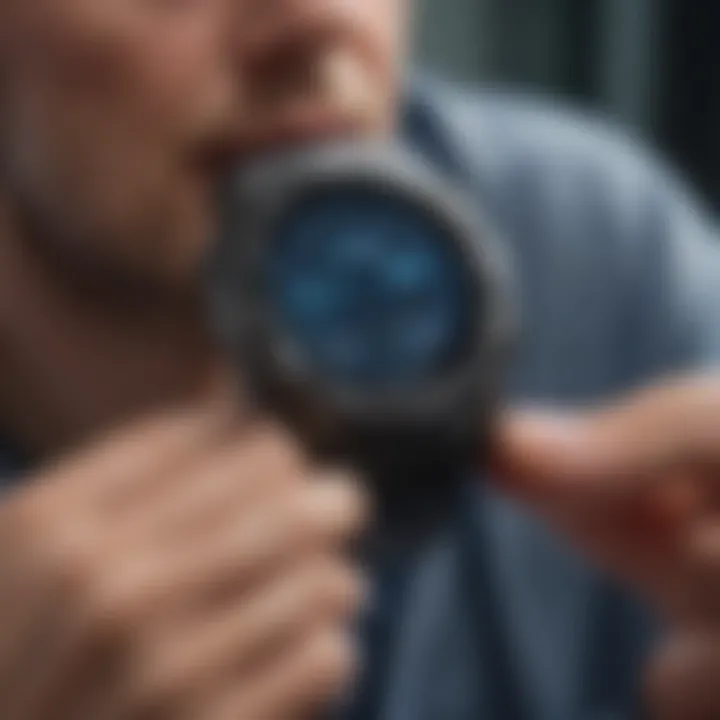
However, you must consider potential challenges, including cost and calibration requirements. Despite these, the overall trend indicates a growing dependence on such devices, aligning with a vision of smarter diabetes management.
Clinical Efficacy of Needle-Free Monitors
The clinical efficacy of needle-free monitors stands out as a critical topic in the context of diabetes management. As diabetes prevalence rises globally, the demand for effective yet less invasive glucose monitoring solutions becomes more pressing. Needle-free monitors offer significant advantages, addressing healthcare professionals’ concerns about patient adherence and the psychological barriers associated with traditional needle-based monitoring. Monitoring a patient's glucose levels accurately is paramount. Therefore, understanding the performance metrics of these devices is essential.
Accuracy and Reliability
Accuracy and reliability remain central to the discussion surrounding needle-free glucose monitors. These devices aim to provide readings comparable to traditional methods while minimizing discomfort for the patient. Clinical studies have shown variable accuracy across different needle-free technologies, prompting ongoing evaluation. The effectiveness of a monitor is often assessed by comparing its readings against standard laboratory tests. Successful devices should ideally exhibit a Mean Absolute Percentage Error (MAPE) within acceptable limits when tested against traditional methods. Recent advancements in sensor technology and algorithm refinement have improved the precision of several devices. Nonetheless, healthcare practitioners must evaluate specific products carefully to ensure their suitability for patient profiles.
An effective needle-free monitor must also deliver consistent readings over time. Patients using these devices should experience minimal variation in glucose readings when rechecking within short intervals. The reliability of these monitors directly impacts their adoption; fluctuations in accuracy can lead to incorrect treatment decisions, emphasizing the need for continual development in this field.
"Reliability in glucose readings can significantly shift a patient’s trust in the monitoring device, leading to better management of diabetes."
Comparison with Traditional Blood Glucose Measurements
When comparing needle-free monitors to traditional methods, such as fingerstick blood glucose tests, several factors warrant consideration. First, convenience plays a significant role; with needle-free options, patients can often take readings without breaking the skin. This aspect enhances the appeal, particularly for individuals who fear needles or experience anxiety around frequent pricking. Moreover, the ability to monitor glucose levels non-invasively can encourage consistent usage among patients.
However, while the reduction in discomfort is commendable, it is essential to recognize that traditional methods have established reliability and accuracy. Fingerstick tests are widely regarded as the gold standard in glucose monitoring. As a result, many clinicians are hesitant to fully embrace newer technology without robust validation.
As technology progresses, some needle-free devices now incorporate features such as continuous glucose monitoring, offering patients real-time insights into their glucose levels. This advancement represents a qualitative leap over traditional testing that often only gives a snapshot at one time point. The integration of wireless connectivity and mobile applications further enhances user engagement by making it simpler to track glucose levels over time.
The decisions between methods of monitoring glucose are not solely based on accuracy. Factors such as cost, ease of use, and patient experience should inform clinical judgment. Adopting a needle-free option can lead to improved overall patient satisfaction, which is an increasingly important aspect of care in diabetes management.
Patient Adherence to Monitoring Practices
Patient adherence is critical in the realm of diabetes management. It refers to the extent to which patients follow their prescribed monitoring routines, which often includes regular blood glucose testing. When patients adhere to these practices, they gain better control over their condition and reduce the risks of complications. The introduction of needle-free glucose monitoring technologies has the potential to significantly enhance patient adherence due to several specific elements.
Impact of Reduced Pain on Patient Compliance
Needle-free glucose monitors fundamentally aim to minimize discomfort during the monitoring process. Traditional methods, involving finger pricks, can cause pain and anxiety which often leads patients to avoid regular testing.
By eliminating needles, these innovative devices tend to make glucose monitoring a more palatable experience. Studies suggest that reducing pain can lead to higher compliance rates. Patients are more likely to engage in regular monitoring when they do not associate it with pain. A study conducted by the Journal of Diabetes Science and Technology indicated that patients using needle-free devices reported greater satisfaction and willingness to monitor their glucose levels regularly compared to those using traditional methods. This indicates that the advanced technology can potentially transform the patient's approach to self-monitoring, positively influencing their overall health management.
User Experience and Design Considerations
User experience plays a vital role in ensuring patient adherence to glucose monitoring practices. A well-designed needle-free glucose monitor should be intuitive and easy to use. If a device is cumbersome or complex, patients may become discouraged. The design should focus on functionality and aesthetics, striking a balance that appeals to users.
Key design elements include:
- Ergonomic Shape: Comfortable to hold and operate.
- Clear Display: Easy to read results without strain.
- Portable: Convenient for everyday use, allowing patients to monitor their levels on the go.
- Durability: Designed to withstand everyday handling while maintaining accuracy.
Furthermore, incorporating features such as smartphone compatibility can enhance user experience. Many patients prefer to track their glucose levels through an application, allowing for seamless data management. According to a report from the International Diabetes Federation, patients utilizing integrated technology demonstrate improved adherence, as they are able to visualize their data over time and gain insights into their health trends.
In summary, by addressing pain points in design and enhancing overall user experience, needle-free glucose monitors can greatly affect patient adherence to monitoring practices. A focus on reducing discomfort, coupled with thoughtful design, not only fosters consistency in monitoring but also plays a part in fostering a proactive approach to diabetes management.
Challenges Facing Needle-Free Technologies
The exploration of needle-free glucose monitoring technologies is not without its challenges. Understanding these obstacles is crucial for evaluating the viability and future of these devices. Addressing cost implications and regulatory hurdles can significantly influence the acceptance and integration of needle-free monitors in diabetes care.
Cost Implications for Patients and Healthcare Systems


Needle-free glucose monitoring devices can come with higher upfront costs compared to traditional blood glucose testing methods. Patients may face increased expenses due to the price of these innovative systems. In many cases, insurance coverage may not fully extend to these devices, leaving patients to bear the brunt of the financial burden. The implications of this are substantial.
For healthcare systems, the initial investment in new technology can be daunting, impacting budgets and resource allocation. Furthermore, if these needle-free devices do not show clear long-term cost benefits through reduced complications or hospitalizations, the justification for their use may weaken.
Ultimately, the balance between cost and patient care is tight and needs thorough evaluation. If the benefits of these devices, such as reduced pain and improved adherence, surpass the costs, they may pave the way for wider acceptance. A focus on cost transparency and increasing insurance coverage could ease the financial strain for patients, promoting the acceptance of needle-free technologies.
Regulatory Hurdles
The regulatory landscape for medical devices is complex, and needle-free glucose monitors are no exception. Navigating the approval process can be challenging and time-consuming. Regulatory bodies, such as the Food and Drug Administration (FDA) in the United States, require robust evidence of safety and effectiveness before approving new technologies.
This scrutiny is necessary but can also slow down the introduction of beneficial technologies to the market. Developers must conduct extensive clinical trials, demonstrating not only that these devices work but that they outperform traditional methods in reliability and accuracy.
Several key factors are considered, including:
- Safety: Ensuring that the devices do not cause adverse reactions or complications.
- Performance: Maintaining accuracy in glucose readings comparable to established methods.
- Post-market Surveillance: Ongoing monitoring to track the real-world performance and safety of the devices.
Each of these factors contributes to the overall timeline for bringing needle-free technologies to market. Delays in regulatory approval can prevent those needing innovative solutions from accessing them promptly. Efforts to improve communication and information sharing between developers and regulators may help mitigate some of these hurdles.
"The future of needle-free glucose monitoring heavily relies on overcoming regulatory and financial barriers while ensuring patient safety and satisfaction."
In summary, although needle-free glucose monitoring technologies hold great potential, they face significant challenges that must be addressed. By focusing on cost implications and navigating regulatory hurdles, stakeholders can aid in their successful integration into diabetes management.
Future Directions in Needle-Free Monitoring
The evolution of needle-free glucose monitoring technologies holds significant promise for the future of diabetes management. As the demand for less invasive monitoring solutions increases, the focus shifts towards improved accuracy, patient comfort, and integration with other health technologies. Understanding future directions in this field is crucial for students, researchers, educators, and professionals alike, as it shapes the landscape of diabetes care in the years to come.
Innovations on the Horizon
Recent developments in technology present numerous innovations poised to enhance needle-free glucose monitoring. Emerging methods may include improved sensors that provide faster and more accurate readings. For instance, advancements in hydrogel-based sensors can potentially allow for real-time glucose monitoring with a high degree of precision.
Another area of innovation is the application of biosensors combined with nanotechnology. This coupling can yield highly sensitive devices that respond to minute changes in glucose levels. Additionally, portable devices equipped with microfluidic technology are in development, which may deliver laboratory-level accuracy in a convenient format.
Innovations also address user experience. Companies are exploring designs that are user-friendly and aesthetically appealing, breaking the stigma against diabetes monitoring devices. Those changes are likely to improve adherence among users who may find traditional methods cumbersome or distressing.
Integration with Digital Health Technologies
The integration of needle-free glucose monitoring systems with digital health technologies represents a transformative shift in diabetes management. With the rise of mobile health applications, patients can monitor their glucose levels alongside other health metrics in a single interface.
Such integration can facilitate data sharing with healthcare providers, supporting proactive management of diabetes. Moreover, utilizing cloud-based solutions offers a pathway for real-time data analysis, predicting trends in glucose levels. This capability allows for timely interventions that can enhance patient outcomes.
Emphasis is also placed on interoperability. The future of needle-free monitoring may see devices that work seamlessly with existing health ecosystems, including fitness trackers and electronic health records. This unified approach not only enriches the patient's overall health experience but also empowers healthcare professionals with comprehensive data.
End
The discussion surrounding needle-free glucose monitoring technologies highlights their increasing significance in diabetes care and management. As these innovative devices evolve, they present a promising solution to the discomfort and inconvenience associated with traditional blood glucose monitoring methods. Just as critical as the technology itself is the acknowledgment of the broader implications these advancements have on patient lifestyle, well-being, and adherence to monitoring regimens.
Summary of Key Insights
Needle-free glucose monitoring technologies have shown considerable promise in various domains:
- Patient Comfort: By eliminating needles, the pain associated with frequent blood draws is reduced, making compliance more attainable for individuals managing diabetes.
- Innovation: Devices like transdermal patches and microneedles demonstrate distinct mechanisms that allow for effective glucose monitoring without traditional drawbacks.
- Clinical Efficacy: Research indicates that many needle-free devices are approaching the accuracy levels of conventional methods, which has positive implications for their acceptance within healthcare protocols.
The integration of these technologies into diabetes management could reshape how patients approach their health, enabling more proactive and engaged self-care. Improved accessibility and lower barriers to monitoring can lead to better outcomes overall.
Final Thoughts on Glucose Monitoring Advances
The trajectory of needle-free glucose monitoring hints at a future where diabetes management evolves significantly. Integrating these technologies with existing digital health infrastructures can amplify their benefits. As the healthcare landscape gravitates towards user-centric solutions, the potential for needle-free devices to democratize health analytics becomes apparent. However, regulatory challenges and cost considerations remain significant hurdles that require strategic solutions.
To effectively harness the potential of needle-free systems, stakeholders must prioritize research, investment, and patient education. As advancements continue to unfold, the impact on public health and diabetes care could be profound, leading to improved quality of life for countless individuals.



